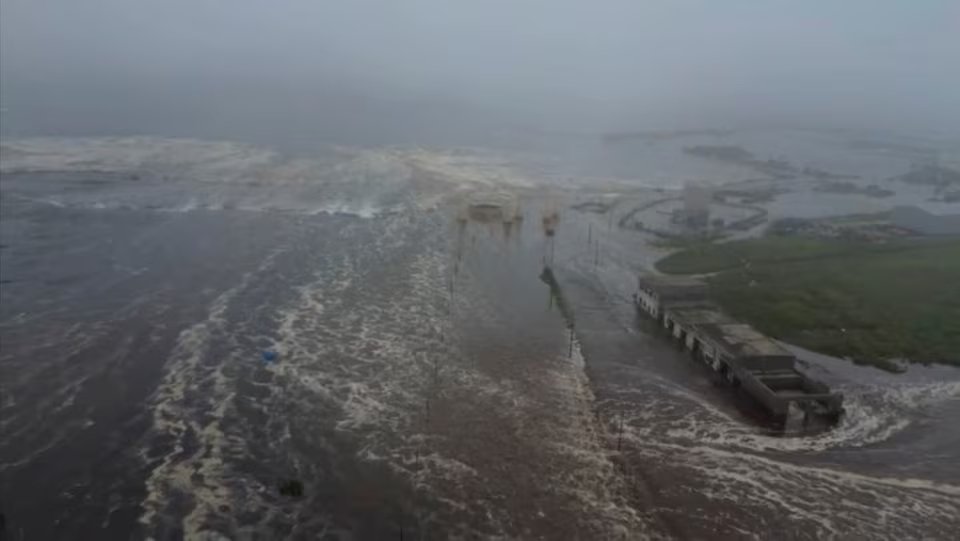
JULY 30 – A powerful earthquake measuring 8.8 on the Richter scale jolted Russia’s remote Kamchatka Peninsula, triggering significant tsunami waves that have since reached Hawaii and other regions across the Pacific. The massive quake, which struck early Wednesday, led to evacuation orders, structural damage, and widespread alarms throughout the Pacific Basin.
The seismic event, centered near the city of Petropavlovsk-Kamchatsky, is being described by Russian authorities as the strongest to hit the region since 1952. Waves measuring between 3 to 5 meters battered the Kamchatka coastline, with water flooding ports and damaging infrastructure in towns such as Severo-Kurilsk. Emergency services confirmed that several people required medical attention, although no fatalities have been officially reported in Russia.
Tremors and Tsunami Spark Chaos Across Pacific
The quake’s shallow depth—measured at just 19 kilometers—intensified its impact. Residents in Petropavlovsk-Kamchatsky reported prolonged and violent shaking. “It felt like everything could collapse. The floor wouldn’t stop moving,” said Yaroslav, a 25-year-old resident who fled his building as the tremors persisted for nearly three minutes.
In Severo-Kurilsk, tsunami waves swept through the port and a fish processing plant, dislodging vessels and damaging equipment. Four distinct tsunami waves were recorded, with some exceeding 5 meters. The town’s mayor, Alexander Ovsyannikov, urged residents to inspect homes for damage and avoid using gas stoves until safety checks could be conducted, warning of possible carbon monoxide risks.
Elsewhere in the Russian Far East, power outages affected parts of the Sakhalin region due to damage in the electrical grid. Emergency officials also reported minor damage to a kindergarten but confirmed that most infrastructure had withstood the quake.
The Kamchatka Peninsula, part of the seismically active Pacific “Ring of Fire,” frequently experiences tectonic activity, but this latest quake stands out for its sheer intensity. According to Danila Chebrov, director of the Kamchatka Branch of the Geophysical Service, the shaking wasn’t as violent as might be expected from a quake of this size, possibly due to unique geological factors at the epicenter. However, he confirmed that strong aftershocks, some approaching magnitude 7, were continuing and would likely persist for some time.
Hawaii, Japan, and Other Pacific Regions on Alert
The force of the quake reverberated across the Pacific, with tsunami warnings issued for Hawaii, Japan, the U.S. West Coast, and several other nations. Emergency officials in Hawaii urged residents in low-lying coastal zones to evacuate without delay, warning, “Take immediate action, dangerous tsunami waves are anticipated,” Honolulu Department of Emergency Management shared online.
By 3:30 AM EDT, waves of up to 1.7 meters had reached the Hawaiian Islands. Although no major damage was immediately reported, all flights into and out of Maui were canceled as a precaution. Governor Josh Green urged residents to stay alert and avoid coastal zones until further notice.
Japan also issued widespread tsunami warnings along its eastern coastline. Tens of thousands were urged to evacuate as sirens blared in coastal cities. At the Fukushima nuclear power plant—site of the 2011 nuclear disaster triggered by a tsunami—workers were evacuated as a precaution. However, no irregularities were reported at any nuclear facilities.
Asahi TV broadcaster footage from Hokkaido showed residents gathered on rooftops seeking safety from the incoming waves. Fishing vessels were spotted heading out to sea in an effort to steer clear of potential damage. Tragically, a 58-year-old woman in Mie Prefecture lost her life when her car plunged off a cliff while she was evacuating.
Japan recorded three separate tsunami waves, the largest of which reached 1.3 meters. Officials warned that even waves as low as 1 meter can be deadly, particularly for those caught in open water or swept away by debris. Wooden structures along the coast also face significant risk from flooding and impact damage.
In response to the crisis, automaker Nissan temporarily halted operations at several of its factories in Japan to prioritize employee safety.
The U.S. Tsunami Warning System issued alerts for potential hazardous waves across the Pacific, noting that waves between 1 and 3 meters could hit countries including Chile, Ecuador, the Solomon Islands, and parts of the northern Hawaiian islands. Waves over 3 meters were projected in some Russian and South Pacific territories.
U.S. President Donald Trump emphasized the gravity of the situation in a social media post, noting that a tsunami warning had been issued for Hawaii following a powerful earthquake in the Pacific Ocean.
Aftershocks Continue, Monitoring Ongoing
Although the immediate threat of another large quake has subsided, seismic monitoring agencies caution that aftershocks are likely to continue for several days. The strongest aftershock reported so far has measured 6.9 in magnitude. Geophysicists noted that while another event as large as the initial quake is unlikely in the short term, constant monitoring will remain essential.
Across the Pacific region, emergency services remain on high alert. In Russia, medical staff and disaster response teams are continuing to provide assistance. In Hawaii, shelters have been opened for displaced residents, and public advisories are being updated as more data comes in.
With the Pacific Ring of Fire constantly shifting, this event is a stark reminder of the volatile forces beneath the Earth’s surface. While initial damage appears manageable in some regions, the situation remains fluid and under close observation.
